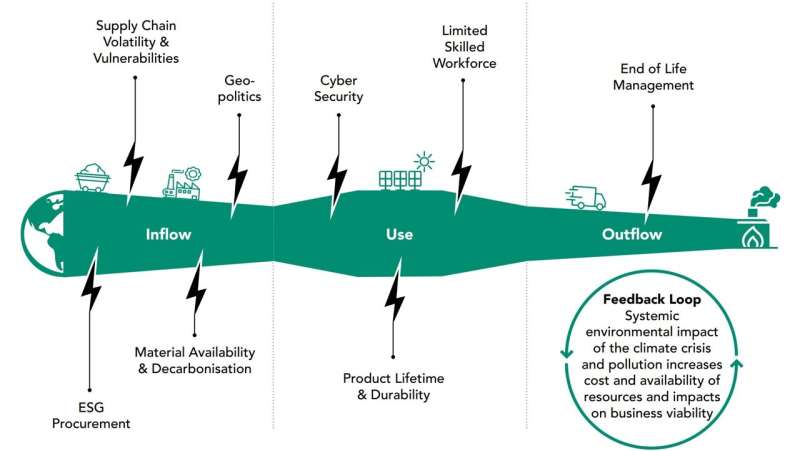
A new report on the solar industry warns “the time is now” to implement circular economy measures that help it meet government Net Zero targets.
The report “From Linear to Circular: Evidence from the UK solar sector” highlights a number of circular economy initiatives that are leading the way, including a project where used car tires could play a role in manufacturing solar panels, and another where old solar panels have been revived for use in the reconstruction of Ukraine.
The report outlines and addresses environmental concerns over the amount of materials embedded in UK solar installations (an estimated 152,523 tonnes of aluminum, 8,745 tonnes of copper and 667,947 tonnes of glass by the end of 2023) and how they could become a problematic waste stream in the future.
It advocates for a wholesale rethink of product design, material use and end-of-life management so that materials and products are kept in circulation for as long as possible, warning that this is imperative to the UK’s Net Zero Strategy and target of 70 GW solar capacity by 2035.
Report co-author Ananda Nidhi, an Impact Fellow at the Exeter Centre for the Circular Economy and CE-Hub of NICER program, said, “By adopting circular economy principles, the UK solar industry can enhance resource security and reduce reliance on often volatile global supply chains by prioritizing the reuse and recycling of materials within the UK.
“It could also tackle the estimated 1.2m tonnes of solar waste that could be generated by 2050 by keeping over $2 billion worth of aluminum, copper and silver embedded in solar PVs in use, while at the same time generating between $0.46bn from increased recycling rates.
“A circular economy also has the potential to stimulate economic growth by creating new jobs and fostering the development of businesses in the repair, refurbishment and recycling sectors.”
The research team, which also included Professors Peter Hopkinson, Fiona Charnley and Markus Zils from the University of Exeter Business School and Ph.D. student Matt Burnell, interviewed solar industry experts and stakeholders and conducted a literature review before constructing an analysis of the flow of materials in the UK solar sector with forward projections to 2050.
The report outlines core areas of focus across the solar value chain that will spark a transition to a truly circular economy.
For materials and products coming into the supply chain this means increasing focus on sourcing sustainable materials, designing products that are more easily reused, repaired and recycled, as well as implementing systems to trace the origin and lifecycle of materials to promote transparency and accountability throughout the supply chain.
Initiatives that are leading the way include a NICER program-funded project that explores the potential of using recycled carbon black from used vehicle tires in high-value applications like solar photovoltaics.
The project’s research team found that carbon black from used tires could match or even surpass the performance of pure materials, providing a circular alternative to incineration or landfill for the 29 million tonnes of vehicle tires that reach the end of their lifespan globally each year.
Another example of product re-use is Hammersmith & Fulham Council’s collaboration with Cornish start-up Re-Solar to rescue and rehome solar panels, a project which showcased the potential for a secondary market for used solar panels.
The panels, which still had more than 10 years of operational life, were sent to the Ukraine to help provide renewable decentralized power to Ukraine at a time when its traditional energy source are under continual threat.
The report also outlines circular strategies for products already in use that aim to maximize their lifespan and minimize resource consumption.
Projects leading the way include start-up Re-Solar, which embarked on a project in 2022 to explore the energy generation and reuse potential of damaged solar panels, demonstrating how refurbishment could support the UK solar industry to reduce waste, prolong operational lifespan and delay the point for recycling or disposal.
The report also identifies the barriers to circularity, such as a lack of end-of-life policies, design limitations and data gaps and addresses these barriers with recommendations for key stakeholder groups: policymakers/regulators, manufacturers, supply chain partners, third-party/certification bodies and academic institutions.
Nidhi added, “The time to do this is now. The UK solar sector is at a critical juncture, with substantial growth while operating on a linear model. By implementing the recommendations outlined in this report, the UK can lead the way in creating a resilient and sustainable solar energy industry.”